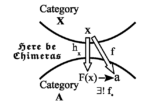Category theory has foundational importance because it provides conceptual lenses to characterize what is important and universal in mathematics—with adjunction seeming to be the primary lens. Our topic is a theory showing “where adjoints come from”.
The heteromorphic approach to adjunctions: theory and history
In this paper, the history and theory of adjoint functors is investigated. Where do adjoint functors come from mathematically, and how did the concept develop historically?
Valuation rings: A better algebraic treatment of Boolean algebras
This is Chapter 11 in my book: Ellerman, David. 1995. Intellectual Trespassing as a Way of Life: Essays in Philosophy, Economics, and Mathematics. Lanham MD: Rowman & Littlefield.
Category Theory as the Theory of Concrete Universals
This is Chapter 8 of my book: Ellerman, David. 1995. Intellectual Trespassing as a Way of Life: Essays in Philosophy, Economics, and Mathematics. Lanham MD: Rowman & Littlefield.
This essay deals with a connection between a relatively recent (1940s and 1950s) field of mathematics, category theory, and a hitherto vague notion of philosophical logic usually associated with Plato, the self-predicative universal or concrete universal. Consider the following example of “bad Platonic metaphysics.”
Given all the entities that have a certain property, there is one entity among them that exemplifies the property in an absolutely perfect and universal way. It is called the “concrete universal.” There is a relationship of “participation” or “resemblance” so that all the other entities that have the property “participate in” or “resemble” that perfect example, the concrete universal.
All of this and much more “bad metaphysics” turns out to be precisely modeled in category theory.
A Basic Duality in the Exact Sciences: Application to QM
This approach to interpreting quantum mechanics is not another jury-rigged or ad-hoc attempt at the interpretation of quantum mechanics but is a natural application of the fundamental duality running throughout the exact sciences.
Heteromorphic Approach to Adjunctions
Saunders Mac Lane famously remarked that “Bourbaki just missed” formulating adjoints in a 1948 appendix (written no doubt by Pierre Samuel) to an early draft of Algebre–which then had to wait until Daniel Kan’s 1958 paper on adjoint functors. But Mac Lane was using the orthodox treatment of adjoints that only contemplates the object-to-object morphisms […]
The Logical Theory of Canonical Maps
The purpose of this paper is to show that the dual notions of elements & distinctions are the basic analytical concepts needed to unpack and analyze morphisms, duality, and universal constructions in the Sets, the category of sets and functions.
Brain Functors: A mathematical model of intentional perception and action
Semiadjunctions (essentially a formulation of universal mapping properties using hets) can be recombined in a new way to define the notion of a brain functor that provides an abstract model of the intentionality of perception and action (as opposed to the passive reception of sense-data or the reflex generation of behavior).
Category theory and set theory as theories about complementary types of universals
This is a paper, published in Logic and Logical Philosophy, on the concept of universals in philosophical logic–which includes the example of “Sophia Loren as “the” Italian women”. The always-self-predicative universals of category theory form the opposite bookend to the never-self-predicative universals of iterative set theory.






